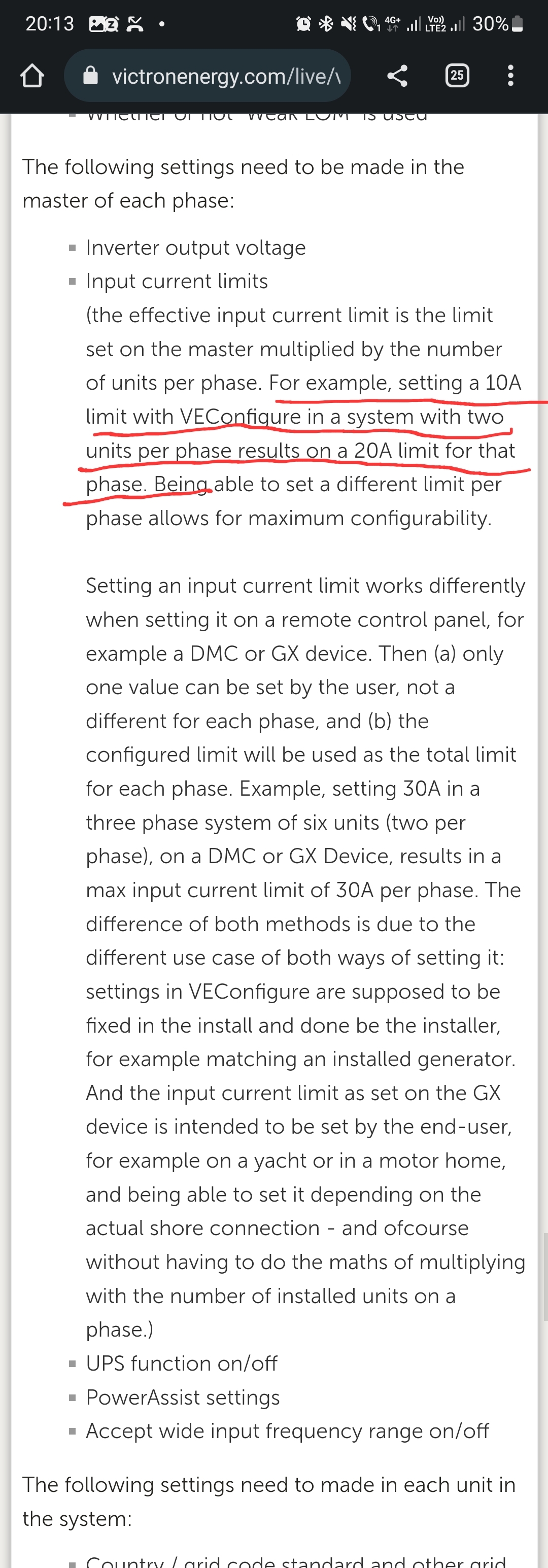Hello people. A few months ago i discovered a a bug in limiting the input current to AC IN for Multis/Quattros, but ONLY IN PARALLEL SYSTEMS. If I only have 1 Multi/Quattro per phase, the limitation works perfectly, but when I have at least 2 inverters per phase (as is the case with one of my systems - 6 Quattros 15 000, three phase, parallel, 2 Quattros per phase) it no longer works as it should. More precise, if I set In Ve.Bus System Configurator, let's say, a limit of 35 amps for each inverter, that is 70 A per phase and after that I upload the configuration on the inverters, it works ok. If, however, I later need to increase or decrease the respective limit, let's say to 75 A per phase, the VeBus system, normally, as specified in the manual, should divide 75 A by 2 = 37.5A per inverter . But it only does this with the Master inverter, the slave still remains with the initial setting in VeConfigure, in this case, of 35 A. Because I make programming in Node-Red for these systems through which , in order to force the system to take current from the batteries, I set the limitations to AC IN dynamically, depending on the SoC: for example, up to 20%, let me accept a limit of, say, 70A per phase, and below 20%, let me increase limit to 100 A per phase, so that the batteries do not run out at night, this bug prevents me from doing this dynamic AC input limiting. I repeat, this works perfectly for simple single-phase and three-phase systems, but it does not work at all in parallel. I kept hoping that someone from Victron would discover this bug and solve it, but it didn't happen untill now, so maybe they will see this here or maybe someone here has found an workaround. I am also attaching a video/screenshot for better understanding.
- Home
- Anonymous
- Sign in
- Create
- Spaces
- Grafana
- Node-Red
- Unsupported topics
- Questions & Answers
- Modifications
- Communauté francophone
- Deutschsprachiger Bereich
- Preguntas en Español
- Explore
- Topics
- Questions
- Ideas
- Articles
- Badges
question
AC IN Current limiting bug in parallel installations
This is normal in parallel setups. The master is always in control of the slave so the current limit is being controlled by the master and not the slave. The current limit setting in the slave is meaningless.
 No, it's not normal. When you set the limit for 60 amps, for example, the system divides this equally to the number of inverters. If you have 2 inverters, each gets a limit of 30 amps, if you have 3 inverters, each gets a limit of 20 amps, and so on. My issue is that this works perfectly when it's configured via Ve Configure, but it doesn't work when it's configured remotely through the control panel in VRM or through Node-Red.
No, it's not normal. When you set the limit for 60 amps, for example, the system divides this equally to the number of inverters. If you have 2 inverters, each gets a limit of 30 amps, if you have 3 inverters, each gets a limit of 20 amps, and so on. My issue is that this works perfectly when it's configured via Ve Configure, but it doesn't work when it's configured remotely through the control panel in VRM or through Node-Red.
If you set 60A on the master and you have 3 inverters, that equates to 180A.
You are right. And it also should apply the other way around. You set 180A, it should divide it by 3, and set each inverter 60A. But it doesn't do it, it just does it for the master inverter, the slaves remain to the original setting. Watch the video, you can understand better what I'm saying.
Sorry I don't have an answer for you then. In my parallel inverters when I change the input limit thru vrm, node red, or display panel only the master shows the change in the configuration but the overall limit is applied as expected. Maybe someone from Victron can look at your system remotely and offer an explanation.
Edit: one other thought...is all the wiring both ac and DC exactly identical between parallel inverters? Inverters all the same model and within a year or less of manufacturer date? Resistance in wiring and inverters is much more relevant when wiring parallel inverters. Small differences in wiring and resulting variables in resistance can have the effect you are seeing. There is no communication between parallel inverters in regards to "balancing" the loads (what I mean is that the balancing is not 'computer controlled'), this is dependant upon correct wiring and similar resistance values between units.
Put a clamp meter on each unit and compare the current flowing thru each parallel unit. Make sure they are identical. For example, if you have 30 amps flowing thru one unit and 40 amps thru the other paralleled unit then you have an imbalance. There may be enough difference in resistance between units to cause a big imbalance.
Edit to add: you will want to check both AC and DC side for imbalance. Even though the wiring is identical, there may be internal differences in the inverters.
Related Resources
Webinar Part 1 - Intro to Node-Red
Webinar Part 2- Basic Palettes
Webinar Part 3 - Advanced example
Victron Node-RED for dummies guide by Fideri
Node Red Community Space (normally hidden)
Venus OS Large (Node-RED) manual
Victron Node-RED github readme
Victron Node-RED custom nodes docs
Parallel, split- and three phase VE.Bus systems manual
Theory on wiring large systems PDF
Three-phase and parallel system theory training presentation
Three-phase & Parallel installation training video
Additional resources still need to be added for this topic
question details
50 People are following this question.
